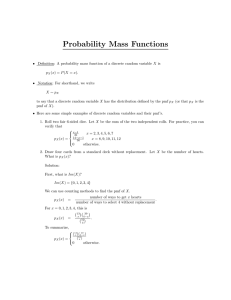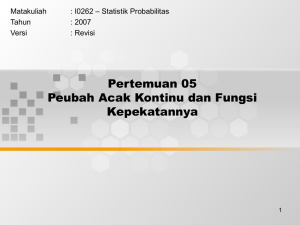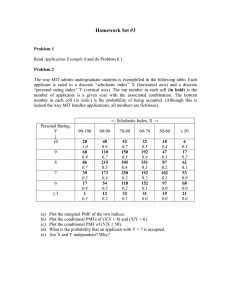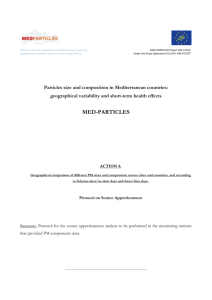Is Solar Cycle 23 Minimum Different? By: Phillip Dietrich
advertisement
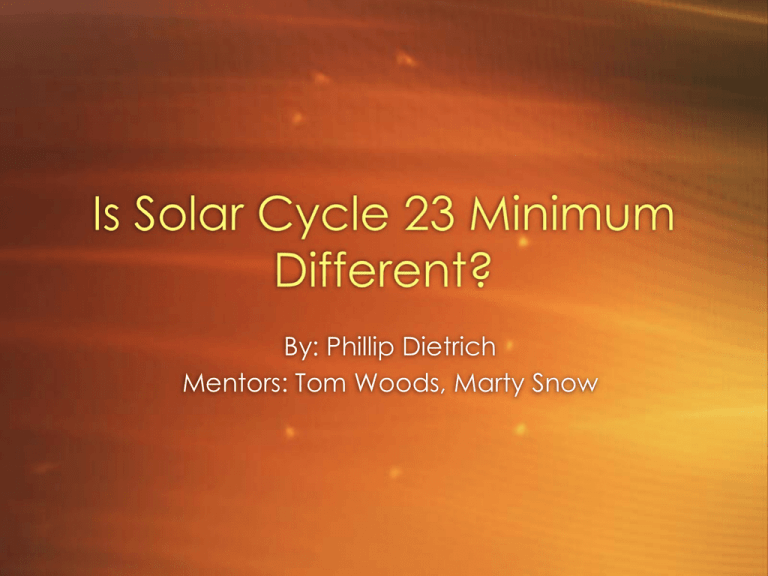
Is Solar Cycle 23 Minimum
Different?
By: Phillip Dietrich
Mentors: Tom Woods, Marty Snow
Solar Overview
Sunspots (SS) are cooler regions of powerful magnetic
flux on the sun
SS follow roughly an 11 year cycle called
the Schwabe cycle
Solar Minimum is determined by a 13 month average of less than
11 or 15 smoothed SS, by spotless days, and by observing
the transition of old/new cycle SS.
At minimum, the suns polar magnetic field (PMF) is at
maximum strength and has strong dipole structure.
The PMF at minimum is a major element used in predictions for following
solar cycle (SC) maximum
Solar maximum is when the monthly averaged SSN has
peaked, which implies times of highest solar activity.
During maximum, the PMF becomes essentially zero
and gains strength of opposite polarity until minimum
The Schwabe cycle is modulated by the
22 year magnetic dynamo
Peculiarities of SC23
• The SC duration, nearly 13 years so far
(and possibly still growing) is the longest since 1870.
• The minimum duration is the longest since the 1920’s.
• The solar wind is not at as close to the equator, in comparison with
previous SC’s. The pressure has decreased by 20%, a 50 year low,
as measured by Ulysses.
• The number of sunspots at minima is the lowest since the
1950’s. 73% of 2008 was spotless days. 76% of 2009 so far has
been spotless days as well.
• The TSI has decreased .02% as measured by VIRGO and
ACRIM.
• The PMF, strongest at minimum, is 40% weaker than previous
SC. The PMF area is also 15% smaller.
My Project
To explain the decreased polar magnetic
field strength in 2008 by modeling the
surface transport of sunspot magnetic field
to the poles throughout solar cycle 23.
The model is then used to make
comparisons with previous solar cycles in
order to understand why this solar
minimum is different.
PMF Data
1997:03:02_21h:07m:13s
1997:03:12_21h:07m:13s
1997:03:22_21h:07m:13s
1997:04:01_21h:07m:13s
1997:04:11_21h:07m:13s
1997:04:21_21h:07m:13s
1997:05:01_21h:07m:13s
1997:05:11_21h:07m:13s
1997:05:21_21h:07m:13s
1997:05:31_21h:07m:13s
1997:06:10_21h:07m:13s
1997:06:20_21h:07m:13s
1997:06:30_21h:07m:13s
1997:07:10_21h:07m:13s
1997:07:20_21h:07m:13s
1997:07:30_21h:07m:13s
1997:08:09_21h:07m:13s
1997:08:19_21h:07m:13s
78N
78N
73N
83N
83N
78N
84N
93N
105N
100N
110N
106N
105N
101N
115N
128N
119N
120N
-127S
-136S
-134S
-122S
-114S
-108S
-112S
-106S
-103S
-90S
-79S
-71S
-65S
-54S
-51S
-44S
-55S
-53S
102Avg
107Avg
104Avg
102Avg
98Avg
93Avg
98Avg
100Avg
104Avg
95Avg
95Avg
89Avg
85Avg
77Avg
83Avg
86Avg
87Avg
87Avg
20nhz
20nhz
20nhz
20nhz
20nhz
20nhz
20nhz
20nhz
20nhz
20nhz
20nhz
20nhz
20nhz
20nhz
20nhz
20nhz
20nhz
20nhz
filt:
filt:
filt:
filt:
filt:
filt:
filt:
filt:
filt:
filt:
filt:
filt:
filt:
filt:
filt:
filt:
filt:
filt:
99Nf -83Sf
91Avgf
99Nf -83Sf
91Avgf
99Nf -83Sf
91Avgf
99Nf -82Sf
91Avgf
99Nf -82Sf
90Avgf
98Nf -82Sf
90Avgf
column headings?
98Nf -81Sf
90Avgf
98Nf -81Sf
89Avgf
97Nf -80Sf
89Avgf
97Nf -80Sf
88Avgf
97Nf -79Sf
88Avgf
97Nf -78Sf
88Avgf
96Nf -78Sf
87Avgf
96Nf -77Sf
87Avgf
96Nf -76Sf
86Avgf
96Nf -75Sf
86Avgf
95Nf -74Sf
85Avgf
95Nf -73Sf
84Avgf
•PMF data obtained from Wilcox Solar Observatory
•Data read in IDL, creating a structure containing turquoise columns
•Date converted to Julian days, and then data is interpolated to have
data for every day
PMF SC23N
• Graph of NPMF with 20nhz filter vs. time
• Want SS model to correlate (reproduce) with this
SS Data
11850106
11850107
11850109
11850109
11850109
11850108
11850108
11850108
11850109
11850109
11850108
11850112
11850112
11850113
11850113
11850113
11850114
1645
1935
1545
0049
0245
1735
1800
1936
0049
0245
1440
1900
2345
0218
1525
2245
0032
N07W18 A
S13W02 A
N17W13( B) 3 24191
S14E11
S14E11 A
N06E66 A
N06E65(AF) 2 24190
N05E66 A
N07E62
N07E61 A
N06E70 B
S08E22 A
S07E20
S06E19 B
S06E10 B
S08E07(BF) 4 24192
S07E07
4614CAXX 1
4614DAXX 2
4614E
4614FAXX 1
4614FAXX 1
4614 AXX 1
4614
4614 AXX 1
4614 AXX 1
4614 AXX 1
4614GBXO 2
4616 AXX 4
4616 BXO 7
4616 BXO 5
4616 DSI 6
4616
4616 DAO 10
2
10
1
10
1
2
3
4
4
3
10
10
10
10
10
20
40
80
6 120
850105.3
850107.7
850108.7
850109.9
850109.9
850113.7
850113.6
850113.8
850113.7
850113.7
850113.9
850114.4
850114.5
850114.5
850114.4
850114.5
850114.5
column headings?
850105.3
850107.7
850108.7
850109.9
850109.9
850113.7
850113.7
850113.7
850113.7
850113.7
850113.9
850114.4
850114.4
850114.4
850114.4
850114.4
850114.4
1 3HOLL
1 2PALE
MWIL
300 3MANI
1 3LEAR
2 3HOLL
MWIL
2 3PALE
299 3MANI
2 3LEAR
2 3RAMY
3 3PALE
301 3MANI
3 2LEAR
295 2BOUL
MWIL
301 2MANI
•SS data obtained from Mount Wilson and USAF
•Every SS is read in IDL, creating structure containing data from turquoise columns
•Each SS is used only at its maximum magnetic strength and at its maximum area
•There exists a power law relationship between the area of a SS group
and its strength, so some missing data pts were filled in this way.
•Bss=Ass.2078
•Bss was scaled 1-6, 1 = 100-500 gauss, 2 600 -1000 gauss, so this was re-scaled
SS model
• Graph of SS contribution to PMF - Drift time to poles, instantaneous magnetic
contribution, decay factor
• Want to accumulate each SS contribution and fit to PMF data with
parameter fitting of transport equations
Model 1 equation: BPMF=(t)
• t1 = [L-(r*)]/v
• Bi = (f*Bssmax - B*t1)
• C(t) = Bi*e-(t-t1-to)
t - time
t1- drift time for SS to reach PMF
to- Julian date of particular SS
L- latitude of PCH
r - radius of sun(m)
- latitude of SS
V- parameter of meridional flow rate(m/s)
F- scaling parameter
Bo-max observed SS B field
b-interaction parameter
decay parameter
Bi- effective SS magnetic field strength
C(t)-contribution function of SS’s.
T1
SS
Model 1 Analysis
• Model correlates to the PMF data by minimizing chisquared for parameters.
• Minimized chi-squared manually & by using ‘mpfit’ in IDL,
which iterates through all parameters simultaneously.
Model 1 Results
• The parameters were dependant on each other.
Therefore, there existed no unique solution.
• Also, I was unable to explain why the model had a
slow onset in comparison to the PMF data.
Model 1a: BPMF = *Bsso
• B and were set to zero in an attempt to have unique
f values for SC comparison.
• The fit was weaker than previous version of model, and
still lacked physical correlation dealing with onset.
• The model was lacking some essential aspect of physics
axis titles?
Model 2
units ok?
BPMFo2 + f*ss2*Ass= BPMF2*APMF
• A conservation of energy argument.
• Total energy of each system is equal to its magnetic
field squared multiplied by the active regions area
• The goal was to solve for f empirically
• Fideal = (BPMFmax-BPMFmin)/BSSmax
axis titles?
f_ideal?
Results/Analysis Model 2
• Fideal correlated only with the tail of PMF data, still
beginning unexplained (wording?)
• Decided to tweak this model with decay factor again
• Graph of BPMF2*APCH & APCH vs. time
Breakthrough
• The observed instant change of PMF energy is due to BSS
connecting to BPMF without needing to physically transport
there. This is because BPMF and leading Bss are of opposite
polarity. This happens as new SC SS appear and until
BPMF = 0.
• When BPMF = 0 and after, we see the time delay again
because BPMF and Bss are same polarity, so Bss will not
interact with BPMF until it reaches the poles by meridional
flow.
{
Model 2a
BPMF2*APMF = BPMFo+, BPMF < 0
BPMF2*APMF = BPMFo+ƒ2*ss2*Ass*e-(t-t1-to) , BPMF 0
•f1- scaling parameter accounting for amount of Bss
that connects to poles
•f2-scaling parameter dealing with interactions while SS transports
to poles by meridional flow
•- decay parameter (0 for BPMF < 0, constant for BPMF 0)
•V- meridional flow rate, represented the same in t1
•Want to minimize chi-squared again for the parameters
•Parameters not as dependant as before because each has physical
meaning for different part of graph
SC23N Chi-squared
SC23N Model 2a vs. Measured PMF
f1= .027
f2= .0018
v=12 m/s
=.00022
SC23S Model 2a vs. Measured PMF
f1=.021
f2=.0018
v=14 m/s
=.00022
SC22N Model 2a vs. Measured PMF
f1=.28 f2=.0038 v=9m/s =.00022
SC22S Model 2a vs. Measured PMF
f1=.24
f2=.0052 v=9.6m/s =.00022
SC Comparison
SC23S
F1=.021
F2=.0018
V=14m/s
=.00022
SC22S
F1=.24
F2=.0052
V=9.6m/s
=.00022
SC23N
F1=.027
F2=.0018
V=12m/s
=.00022
SC22N
F1=.28
F2=.0038
V=9m/s
=.00022
•f1and f2 similar at each hemisphere for the same SC
•f1 is ~10 times greater for SC22 than for SC23. This implies
more SS interactions with PMF before reaching maxima in SC22
•Meridional flow velocity is greater for SC23 than for SC22. This is
consistent with faster meridional flow for SC23 than SC22
(David Hathaway, 09)
Conclusion
• Model 1 could not fit the PMF data with the physical
meaning needed and had no unique solution
• Model 2a correlates to PMF graphically and with
strong physical meaning for parameters.
• For SC23, I visually achieved the PCH data, which
may explain large difference in parameter values
• Currently working on modeling SC21. Hoping that it
correlates to SC22, giving solid foundation for SC23
comparison
• So, SC23 is different, but more consistent PCH data
is needed as well as SC21 comparison to say for
sure how different it is and why it is different
